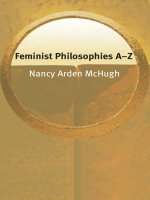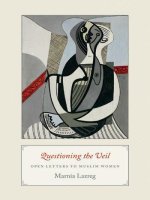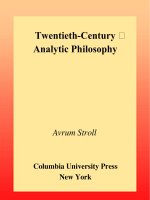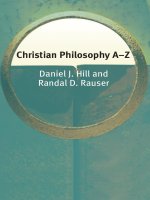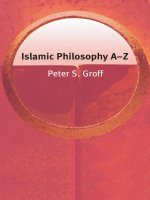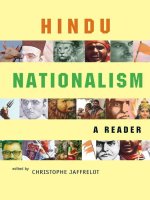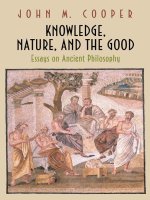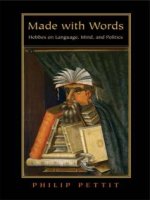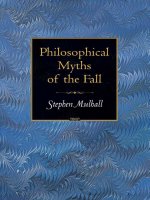princeton university press hindu nationalism a reader jul 2007
Bạn đang xem bản rút gọn của tài liệu. Xem và tải ngay bản đầy đủ của tài liệu tại đây (1.07 MB, 405 trang )
Hindu Nationalism
A Reader
This page intentionally left blank
Hindu Nationalism
A READER
Edited by
Christophe Jaffrelot
PRINCETON UNIVERSITY PRESS
PRINCETON AND OXFORD
Published by
Princeton University Press, 41 William Street, Princeton,
New Jersey 08540
In the United Kingdom: Princeton University Press, 3 Market Place,
Woodstock, Oxfordshire OX20 1SY
In South Asia, published by
Permanent Black
D-28 Oxford Apartments, 11, I.P. Extension,
Delhi 110092
and
‘Himalayana’, Mall Road, Ranikhet Cantt,
Ranikhet 263645
Copyright © Individual extracts by their authors
Copyright © 2007 Volume form by Christophe Jaffrelot
Requests for permission to reproduce material from this work
should be sent to Permissions, Princeton University Press
Library of Congress Control Number 2006940297
ISBN-13: 978-0-691-13097-2 (cloth)
ISBN-10: 0-691-13097-3 (cloth)
ISBN-13: 978-0-691-13098-9 (pbk.)
ISBN-10: 0-691-13098-1 (pbk.)
British Library Cataloging-in-Publication Data is available
This book has been composed in Agaramond
Printed on acid-free paper. 8
press.princeton.edu
Printed in the United States of America
1 3 5 7 9 10 8 6 4 2
For
Bruce D. Graham
This page intentionally left blank
Contents
Acknowledgements
Copyright Statement
PART 1: INTRODUCTION: THE INVENTION OF AN
ETHNIC NATIONALISM
xi
xiii
1
Introduction: The Invention of an Ethnic Nationalism
An Ideological Reaction to the Other: From Reform to
Revivalism in the Nineteenth Century
The Political Turn: The Hindu Sabhas Movement
The Hindu Sangathan Movement: Hindu Nationalism
Crystallizes
The Maharashtrian Crucible of Hindu Nationalism
The Sangh Parivar Takes Shape
Hindu Nationalism and Political Strategy
3
12
14
17
19
PART 2: THE MAKING AND RESHAPING OF
HINDU NATIONALIST IDEOLOGY
27
6
10
1 Swami Dayananda Saraswati
Two Extracts from The Light of Truth (Satyarth Prakash)
2 R.B. Lal Chand
Extract from Self-Abnegation in Politics
29
31
38
40
3 Har Bilas Sarda
Two Chapters from Hindu Superiority: An Attempt
to Determine the Position of the Hindu Race
in the Scale of Nations
50
51
viii
C O N T E N TS
SOCIAL SYSTEM
FOREIGN RELATIONS
4 Madan Mohan Malaviya and Lala Lajpat Rai
Presidential Addresses at Two Hindu Mahasabha
Annual Meetings
MADAN MOHAN MALAVIYA: PRESIDENTIAL ADDRESS,
AS REPORTED (1923)
LALA LAJPAT RAI’S PRESIDENTIAL ADDRESS, AS
REPORTED (1925)
51
56
61
64
64
69
5 Swami Shraddhananda
Extract from Hindu Sangathan: Saviour of the
Dying Race
77
6 Vinayak Damodar Savarkar
Extract from Hindutva: Who is a Hindu?
85
87
79
7 M.S. Golwalkar
Extracts from We or Our Nationhood Defined
Extracts from Bunch of Thoughts
97
98
117
8 Deendayal Upadhyaya
Two Extracts from Integral Humanism
139
141
9 Balraj Madhok
Extracts from Indianization? What, Why and How
158
159
PART 3: HINDU NATIONALIST ISSUES
173
10 The RSS and Politics
Extract from K.R. Malkani, The RSS Story
Extract from Sri Balasaheb Deoras Answers Questions
L.K. Advani’s Concluding Statement at the National
Executive Meeting of the BJP, 18 September 2005
175
179
188
11 Jammu & Kashmir
Extract of a Speech by Shyama Prasad Mookerjee,
in the Lok Sabha, on 7 August 1952
Preface to BJP on Kashmir
193
189
195
207
C O N T E N TS
12 The National Language
Extracts from Bharatiya Jana Sangh, Party
Documents Vol. 5: Resolutions on Education,
etc. and Party Affairs
13 Conversion and the Arithmetic of Religious
Communities
Lala Lajpat Rai on Dalits and Conversions
Extract from Raj Eshwar, Paravartan (Back to
Hinduism): Why and How
ix
218
220
233
235
244
14 Reservation and Social Justice
Extract from RSS Resolves: Full Text of Resolutions
from 1950 to 1983
Extracts from ‘BJP Election Manifesto’, 1991
Lok Sabha Elections
Extract from ‘BJP Election Manifesto’, 1996
Lok Sabha Elections
Extract from ‘BJP Election Manifesto’, 1998
Lok Sabha Elections
Extract from ‘NDA Election Manifesto’, 1999
Lok Sabha Elections
Extract from ‘NDA Election Manifesto’, 2004
Lok Sabha Elections
255
15 Education
Extracts from Murli Manohar Joshi, ‘Reorienting
Education’
269
258
259
261
263
267
268
271
16 Ayodhya, the Babri Masjid, and the Ramjanmabhumi
Dispute
Extract from an Interview of L.K. Advani
Extract from L.K. Advani, ‘The Ayodhya Movement’
279
282
289
17 Defence
Extract from Jaswant Singh, Defending India
299
302
18 Secularism
Extract from Atal Behari Vajpayee, ‘The Bane of
Pseudo-Secularism’
313
315
x
C O N T E N TS
Extract from Atal Behari Vajpayee, ‘Secularism, the
Indian Concept’
318
19 The Economy
Extract from S. Gurumurthy, ‘Swadeshi and
Nationalism’
Extract from Arun Shourie, ‘This is India’s Moment,
But It’s Only a Moment, Can We Grasp It?’
342
20 The Diaspora and Hindu Nationalism
Documents on the California Textbooks Controversy
361
364
Bibliography
345
354
370
Acknowledgements
T
he idea of this book was suggested to me by Rukun Advani
more than four years ago, when he published my book India’s
Silent Revolution. The intention was to present, first, a selection
of writings by historical figures of the Hindu nationalist movement,
and second, a series of issues around which the movement had mobilized, intellectually as well as in the street.
This project made a lot of sense to me, not only because it gave me
an opportunity to share with other readers old and fairly rare books
that were lying on my shelves, but also because, in my previous work,
I often felt frustrated at being able to quote only short passages from
the ideologues of Hindu nationalism. In order to retrace the construction of this discourse over decades, even over centuries, it seemed
necessary to reproduce pages, indeed whole chapters of the foundational
texts.
When I started work on the Hindutva movement in the 1980s, I
was struck by the lack of interest this stream of Indian politics had
sparked thus far. There were very few books on the subject and the past
history of the movement remained largely unknown. In my first book,
The Hindu Nationalist Movement and Indian Politics, I built a narrative
aiming to historicize the movement in order both to identify the
contexts in which it was born—and relaunched in the course of time—
and to analyse its rather consistent intellectual trajectory. Indeed, while
some ideas have undergone transformations, the central corpus of
Hindu nationalism has remained the same, as evident from the notion
of a Vedic Golden Age, which is nascent in the first section of this
reader dealing with Swami Dayananda—a nineteenth-century pioneer—and which still plays a pivotal role in the last section regarding
a twenty-first-century controversy over the writing of history textbooks.
xii
ACKNOW L E D G E M E N TS
This ideological firmness is well in tune with the psychological rigidity
of most leaders of this cadre-based movement.
I am grateful to the publishers, Rukun Advani of Permanent Black
and Fred Appel of Princeton University Press, who have allowed me to
substantiate my interpretation of the Hindu nationalist movement by
quoting its architects at length.
This book is dedicated to Bruce Graham, who initiated me so generously into the study of Indian politics and complexities of the social
sciences. His career stands as a model for all those who wish to cultivate
intellectual and personal honesty.
Last but not least, I say ‘thank you’ to Cynthia Schoch for editing
the Introduction to this reader in an effort to make it flow more naturally to the English-speaking ear!
Copyright Statement
The material used in this book has been taken in the main from sources
that are in the public domain. Each source is footnoted at the start of
a chapter and wherever else required. The author and publisher thank
copyrightholders for reproduction permissions received.
While every effort was made to obtain reproduction rights for material held under copyright, some copyrightholders could not be traced,
either because the publisher had folded up and could not be located,
or because the address provided within the source was defunct, or because no reply was received to a request letter and a follow-up reminder.
Therefore, the author and publisher hereby state that, should any
inaccuracies or omissions be brought to their notice, these will be
rectified within future printings.
PART 1
Introduction: The Invention of
an Ethnic Nationalism
This page intentionally left blank
Introduction
The Invention
of an Ethnic Nationalism
T
he Hindu nationalist movement started to monopolize the
front pages of Indian newspapers in the 1990s when the political
party that represented it in the political arena, the Bharatiya
Janata Party (BJP—which translates roughly as Indian People’s Party),
rose to power. From 2 seats in the Lok Sabha, the lower house of the
Indian parliament, the BJP increased its tally to 88 in 1989, 120 in
1991, 161 in 1996—at which time it became the largest party in that
assembly—and to 178 in 1998. At that point it was in a position
to form a coalition government, an achievement it repeated after the
1999 mid-term elections. For the first time in Indian history, Hindu
nationalism had managed to take over power. The BJP and its allies
remained in office for five full years, until 2004.
The general public discovered Hindu nationalism in operation over
these years. But it had of course already been active in Indian politics
and society for decades; in fact, this ism is one of the oldest ideological
streams in India. It took concrete shape in the 1920s and even harks
back to more nascent shapes in the nineteenth century. As a movement,
too, Hindu nationalism is heir to a long tradition. Its main incarnation
today, the Rashtriya Swayamsevak Sangh (RSS—or the National
Volunteer Corps), was founded in 1925, soon after the first Indian
communist party, and before the first Indian socialist party. In fact,
Hindu nationalism runs parallel to the dominant Indian political
tradition of the Congress Party, which Gandhi transformed into a
mass organization in the 1920s. Indeed, Hindu nationalism crystallized
as an ideology and as a movement exactly at the time when the Congress
4
H I N D U N AT I O N A L I S M : A R E A D E R
became imbued with Gandhi’s principles and grew into a mass movement. It then developed an alternative political culture to the dominant
idiom in Indian politics, not only because it rejected non-violence as
a legitimate and effective modus operandi against the British in the
wake of the discourse of Bal Gangadhar Tilak (1856–1920) and his
apologia in favour of a Hindu tradition of violent action,1 but also
because it rejected the Gandhian conception of the Indian nation.
Mahatma Gandhi looked at the Indian nation as, ideally, a harmonious collection of religious communities all placed on an equal footing.
He promoted a syncretic and spiritual brand of the Hindu religion in
which all creeds were bound to merge, or converge. Even though the
leaders of India’s minorities—especially Muslims—resisted this universalist appeal—in part because Gandhi articulated his views in a
thoroughly Hindu style—the Mahatma insisted till the end that he
spoke on behalf of all communities and that the Congress represented
them all. In the early 1920s he even presided over the destiny of the
Khilafat Committee, which had been founded to defend the Khilafat,
an institution challenged after the defeat of the Ottoman empire in
the First World War.2
Gandhi’s universalist definition of the Indian nation echoed that of
the man he regarded as his guru in politics, Gopal Krishna Gokhale
(1866–1915), and, more generally speaking, of the first generation of
Congress leaders. For the founders of Congress, the Indian nation was
to be defined according to the territorial criterion, not on the basis of
cultural features: it encompassed all those who happened to live within
the borders of British India. Therefore, it was not perceived as being
within Congress’s purview to deal with religious issues which, in fact,
were often social issues—such as child marriage and widow re-marriage—all such issues being those that came under the personal laws of
different denominations. Moreover, the early Congress had started for
1
See C. Jaffrelot, ‘Opposing Gandhi: Hindu Nationalism and Political Violence’, in D. Vidal, G. Tarabout, and E. Meyer, eds, Violence/Non-Violence.
Some Hindu Perspectives (Delhi: Manohar-CSH, 2003), pp. 299–324. On Tilak,
see R. Cashman, The Myth of the Lokmanya (Berkeley: University of California
Press, 1975).
2 See Gail Minault, The Khilafat Movement: Religious Symbolism and Political
Mobilization in India (New York: Columbia University Press, 1982).
I N T RO D U C T I O N
5
this latter purpose a National Social Conference which met at the
same time and in the same place as Congress did, during its annual session, but as a separate body. In contrast with the founders of Congress,
Gandhi acknowledged religious identities in the public sphere, even
as he viewed the nation as an amalgamation of many different communities. In the 1920s and after, however, the legacy of the first-generation
Congress leaders was still pursued and deepened by major Congress
Party figures: the Nehrus, i.e. Motilal Nehru (1861–1931) and his
son, Jawaharlal Nehru (1889–1964), who advocated a liberal nationbuilding process based on individuals, not groups. For Motilal, who
was elected president of the Congress in 1919 and 1928, and for Jawaharlal, who—before independence—occupied the same post in 1929,
1936, and 1946, and who was to become Gandhi’s spiritual son, the
construction of the Indian nation could only be rooted in secular,
individual identities. The Nehrus represented a variant of the universalist standpoint, quite different from that embodied by Gandhi.
Hindu nationalism, like Muslim separatism (a movement which in
India was formed around the same time), rejected both versions of the
universalist view of nationalism articulated by Congress.3 This ideology
assumed that India’s national identity was summarized by Hinduism,
the dominant creed which, according to the British census, represented
about 70 per cent of the population. Indian culture was to be defined
as Hindu culture, and the minorities were to be assimilated by their
paying allegiance to the symbols and mainstays of the majority as
those of the nation. For Congressmen like Nehru this ideology—like
that of the Muslim League or of Sikh separatists—had nothing to do
with nationalism. They branded it with the derogatory term ‘communalism’. But in fact the doctrine that was to become known by the name
‘Hindutva’ fulfilled the criteria of ethnic nationalism.4 Its motto,
‘Hindu, Hindi, Hindustan’, echoed many other European nationalisms
based on religious identity, a common language, or even racial feeling.
All the same, the essential characteristics of Hinduism scarcely lent
themselves to such an ‘ism’. This is, first, because Hinduism has no
3
On this typology, see Gyanendra Pandey, The Construction of Communalism
in Colonial North India (Delhi: Oxford University Press, 1990).
4 I have made this argument in The Hindu Nationalist Movement and Indian
Politics (New Delhi: Penguin, 1999).
6
H I N D U N AT I O N A L I S M : A R E A D E R
‘book’ which can truly be said to serve as a common reference point.
As Louis Renou points out, in Hinduism ‘religious books can be described as books written for the use of a sect.’5 Moreover, Hinduism has
often been described not as a religion but as a ‘conglomeration of
sects’.6 In fact the term ‘Hindu’ derives from the name of a river, the
Indus; it was used successively by the Achaemenids, the Greeks, and
the Muslims to denote the population living beyond that river,7 but
till the medieval period it was not appropriated by the people themselves.8 A ‘Hindu’ consciousness apparently found its first expression
in the seventeenth and eighteenth centuries in the empire of Shivaji,
and then in the Maratha confederacy. But the conquests of the Marathas
in the direction of the Gangetic plain ‘did not imply the existence of
a sense of the religious war based on ethnic or communal consciousness’;9 they resulted from a motivation that was ritual in character—
to restore to the Hindus certain holy places, such as Varanasi, which
were revered throughout India. The development of Hindu nationalism
is therefore a modern phenomenon that has developed on the basis of
strategies of ideology-building, and despite the original characteristics
of a diverse set of practices clubbed under the rubric of Hinduism.
An Ideological Reaction to the Other: From Reform
to Revivalism in the Nineteenth Century
The first expression of Hindu mobilization emerged in the nineteenth
century as an ideological reaction to European domination and gave
5
L. Renou, Religions of Ancient India (New Delhi: Munshiram Manoharlal,
1972), 2nd edn, p. 50.
6 R. Thapar, ‘Imagined Religious Communities? Ancient History and the
Modern Search for a Hindu Identity’, Modern Asian Studies, vol. 23, no. 2,
1989, p. 216.
7 R.E. Frykenberg, ‘The Emergence of Modern Hinduism as a Concept and
as an Institution: A Reappraisal with Special Reference to South India’, in G.D.
Sontheimer and H. Kulke, eds, Hinduism Reconsidered (Delhi: Manohar Publications, 1989), p. 30.
8 See, for instance, J.T.O’Connell, ‘The Word “Hindu” in Gaudiya Vaishnava
Texts’, Journal of the American Oriental Society, vol. 93, no. 3, 1973, pp. 340–
4.
9 C.A. Bayly, ‘The Pre-History of “Communalism”? Religious Conflict in
India 1700–1800’, Modern Asian Studies, vol. 19, no. 2, 1985, p. 187.
I N T RO D U C T I O N
7
birth to what came to be known as ‘neo-Hinduism’.10 To begin with,
Europeans fascinated the local intelligentsia. In Bengal, where the
British first settled, the East India Company used the services not only
of compradores but also of the local literati, who came from the Hindu
upper castes—these bhadralok, who were mostly Brahmins and, as a
result, a new elite of upper-caste British-trained white-collar workers
took shape.11 This intelligentsia often admired Britain for its remarkable
scientific, technical, legal, and social achievements.
Yet most members of this intelligentsia also regarded the West as
a threat. They were inclined to reform their traditions along modern
lines but not to the extent that they would abandon or even disown
them; in fact they often wanted to reform these traditions in order to
save them. Reformists, therefore, became revivalists by pretending
that, in emulating the West, they were only restoring to pristine purity
their own traditions via eliminating later accretions.
Within the Hindu milieu this transition from reform to revivalism
took place in the course of the nineteenth century. This is well illustrated
by the contrast between the Brahmo Samaj and a later—but not unrelated—organization, the Arya Samaj. The former was founded in
1828 by Ram Mohan Roy (1772–1833), the renowned Bengali Brahmin who had been employed by the East India Company and who
looked at the British presence in India as a providential development.12
Roy supported Western reformist ideas, including the abolition of
sati. At the same time, he was very critical of the proselytizing work of
Western missionaries. He steadfastly vindicated Hinduism against
Christian expansionism, though in the reformist way. He admitted
that missionaries were right when they stigmatized polytheism, the
caste system and the condition of Hindu women. But he argued that
these retrograde practices were latter accretions in Hinduism, that in
its original form Hinduism did not lay itself open to such opprobrium.
10 On neo-Hinduism see K. Jones, Socio-Religious Reform Movements in British
India (Cambridge: Cambridge University Press, 1989); and A. Copley, ed.,
Gurus and their Followers: New Religious Reform Movements in Colonial India
(Delhi: Oxford University Press, 2000).
11 On this peculiar category, see J.H. Broomfield, Elite Conflict in a Plural
Society: Twentieth-century Bengal (Berkeley: University of California Press, 1968).
12 S.D. Collet, The Life and Letters of Raja Ram Mohan Roy (Calcutta: Sadharan Brahmo Samaj, 1962).
8
H I N D U N AT I O N A L I S M : A R E A D E R
It had ignored idol worship—in fact it was even more monotheistic
than Christianity, which admitted the Trinity—and it was an egalitarian
creed emphasizing unmediated access between the individual and God.
Roy argued that he had discovered all these virtues in the Upanishads—
a late addition to Vedanta, the most recent part of the Veda.13 He suggested that, according to these sacred texts, each man is endowed with
an atma, which is nothing other than a part of Brahma—the divine
substance that supports the world. Therefore, the Vedic religion relied
on an unmediated relation between man and God. He fought with
Unitarian missionaries to hammer home this point during long public debates. The notion of a Vedic ‘golden age’ when Hinduism was
superior to Christianity can be seen to crystallize at this time.14 This
idea was embodied in the doctrine of the Brahmo Samaj (Society of
Brahma), the organization he founded in 1828 and which survived
Roy’s death in 1833 (in London, where he had travelled as the first
major Hindu reformer).15
The Brahmo Samaj attracted Hindu reformists from various regions,
including the Bombay Presidency. This was the region from which
Swami Dayananda Saraswati came. Dayananda was a Gujarati Brahmin
who had embraced sanyas (asceticism). He travelled to Calcutta in
1873, meeting Keshab Chandra Sen—the most famous Brahmo Samaji
leader of the time—who had just returned from England and was
especially critical of the moral decay of that otherwise modern country.16
Sen promoted the idea that India was technically less advanced but
spiritually superior.17
13
See B.C. Robertson, Raja Rammohan Ray: The Father of Modern India
(Delhi: Oxford University Press, 1995).
14 See H.C. Sarkar, ed., English Works of Raja Rammohun Roy, vol. 1 (Calcutta:
Brahmo Samaj Centenary Committee, 1928).
15 On the Brahmo Samaj, see D. Kopf, British Orientalism and the Bengal
Renaissance (Calcutta: Firma K.L. Mukhopadhyay, 1969) and idem, The Brahmo
Samaj and the Shaping of the Modern Indian Mind (Princeton: Princeton University Press, 1979).
16 See M. Borthwick, Keshub Chandra Sen: A Search for Cultural Synthesis
(Calcutta: Minerva Associates, 1977).
17 This aspect of neo-Hinduism is scrutinized in T. Raychaudhuri, Europe
Reconsidered: Perceptions of the West in Nineteenth-Century Bengal (Delhi: Oxford
University Press, 1988).
I N T RO D U C T I O N
9
Dayananda Saraswati capitalized on the intellectual legacy of Roy
and Sen in the 1870s, but he also took it several steps further, and in
a somewhat different direction. While the Brahmo Samajis focused
on the religious dimension of the Vedic ‘golden age’, Dayananda argued
that, in addition to its spiritual glory, Indian antiquity was imbued
with cultural and social greatness. The Vedic epoch was in his construction no longer embodied only in spirituality but also in a people—
in its culture and its land. Dayananda maintained that the ‘Aryas’
of the Vedas formed the autochthonous people of Bharat, the sacred
land below the Himalayas. They had been endowed by their god with
the most perfect language, Sanskrit, the mother of all languages. This
claim was strengthened by British Orientalism, whose most famous
eighteenth-century exponent William Jones argued that it was the
fount of an Indo-European family of languages. The idea that Europe’s
languages originated in Sanskrit had by this time become widespread.18
Last, but not least, Dayananda depicted Aryan society as endowed
with robust egalitarian values. He did not ignore the caste system, but
he reinterpreted it, arguing that, to begin with, this social system did
not rely on hereditary hierarchical relations but on a merit-based division of labour, each varna fulfilling complementary functions. In the
original Aryan society, for Dayananda, children were assigned to different varnas by their gurus according to their aptitude and inclination,
a novel idea which reflected the influence upon him of Western individualism.
In fact, Dayananda’s revivalism inaugurated a specific combination
of stigmatization and emulation of the threatening ‘Other’. In contrast
to the old reformists à la Ram Mohan Roy, Dayananda did not look
upon British colonialism as a providential development but rather as
posing a threat to Hindu civilization, including its caste system. In
order to defuse this threat Dayananda recommended some emulation
of the West. In this respect he followed Roy. His idea of reform was not
to make India like the West, but to make its standards acceptably
Western. His effort was to dissuade the British from changing Hindu
18
See P.J. Marshall, ed., The British Discovery of Hinduism in the Eighteenth
Century (Cambridge: Cambridge University Press, 1970), and W. Halbfass,
India and Europe: An Essay in Philosophical Understanding (New York: State
University of New York, 1988).
10
H I N D U N AT I O N A L I S M : A R E A D E R
customs by law, as well as to dissuade Hindus from admiring the West
and/or converting to Christianity. This was best done by arguing that
what fascinated Hindus about the West existed already, deeply buried,
in their own ancestral traditions. Dayananda’s interest was thus to
emulate the West in order to more effectively resist its influence.
It followed that the conversion of Hindus—including the Untouchables—to Christianity was perceived by Dayananda as a challenge to
Hinduism. By the end of his life he introduced a ritual of reconversion—something no one could find in the Hindu scriptures as having
previously existed. For this purpose he adapted the old ceremony of
shuddhi, by which upper-caste Hindus who had been defiled could reintegrate with their caste. Shuddhi was therefore a purification procedure which Dayananda transformed into a reconversion technique,
drawing inspiration from Christianity.19 Dayananda presided over the
‘shuddhization’ of a few Christian converts who wished to return to
Hinduism during his lifetime, but even at that time, and more so after
his death, the prime target of the Shuddhi movement’s disciples were
Muslims and Sikhs.20
Dayananda founded the Arya Samaj in 1875, in Punjab, the province
where Hindus, more than anywhere else, felt a strong sense of vulnerability because of their demographic weakness vis-à-vis Muslims
(51 per cent of the local population) and Sikhs (7.5 per cent). After
Dayananda’s death the Arya Samaj continued to develop in Punjab
and became politicized.21
The Political Turn: The Hindu Sabhas Movement
In Punjab the Arya Samaj attracted upper-caste notables who were involved in trade and commerce. This social milieu appreciated the
19
R.K. Ghai, Shuddhi Movement in India (New Delhi: Commonwealth
Publishers, 1990).
20 K. Jones, ‘Ham Hindu Nahin: Arya–Sikh Relations, 1877–1905’, Journal
of Asian Studies, vol. 32, no. 3, May 1973.
21 On the Arya Samaj, the best source remains, K. Jones, Arya Dharm—
Hindu Consciousness in Nineteenth-Century Punjab (Berkeley: University of
California Press, 1976). See also Lajpat Rai, The Arya Samaj: An Account of its
Aims, Doctrine and Activities, with a Biographical Sketch of the Founder (New
I N T RO D U C T I O N
11
sect’s reformist creed because it did not recognize any sort of supremacy
by Brahmins—on the contrary it denied the role of Brahmins as intermediaries between man and God. Hitherto, Brahmins had here claimed
to occupy the upper rungs of society, even though the merchant castes
had, in fact, become the dominant force in society.
The merchant castes had indeed become so powerful that they
played the role of moneylenders for the entire Punjab peasantry. When
debtors failed to pay their dues, as often happened, merchant castes
bought their land. This phenomenon accelerated by the late nineteenth
century to such an extent that the British—who wanted to protect
rural society as it had supported their rule—introduced in 1901 the
Punjab Alienation of Land Act, a piece of legislation protecting ‘rural
tribes’ from such transfer of property.22 The British further antagonized
the Hindu elite in 1906 when Lord Minto promised a Muslim delegation—which was to spawn the Muslim League by the end of the
year—that the Muslim minority of India would be granted a separate
electorate. This announcement did not materialize all over British
India until 1909, in the framework of the Morley–Minto constitutional
reforms, but in Punjab it led the Hindu urban elite to organize as early
as 1907: Hindu Sabhas (Hindu associations) were formed throughout
the province, mostly under the impulse of Arya Samaj leaders, including
Lal Chand, who formulated the standard expression of Hindu anxiety
regarding British policy in 1909, in a series of articles in The Panjabee.23
While Arya Samajis, thus far, did not view themselves as ‘Hindus’
but as followers of the Vedas—so much so that they did not declare
themselves ‘Hindus’ in the census—British policy convinced them to
give up this claim and join hands with the other streams of Hinduism,
Delhi, D.A.V. College, 1914); S.K. Gupta, Arya Samaj and the Raj (New Delhi:
Gitanjali Publishing House, 1991); D. Vable, The Arya Samaj: Hindu without
Hinduism (New Delhi: Vikas, 1983); Saraswati Pandit, A Critical Study of the
Contribution of the Arya Samaj to Indian Education (Delhi: Sarvadeshik Arya
Pratinidhi Sabha, 1975); and V. Dua, The Arya Samaj in Punjab Politics (New
Delhi: Picus Books, 1999).
22 N.G. Barrier, The Punjab Alienation of Land Bill of 1900 (Durham: Duke
University Press, 1966).
23 Lajpat Rai, A History of the Arya Samaj (Bombay: Orient Longman, 1967).
